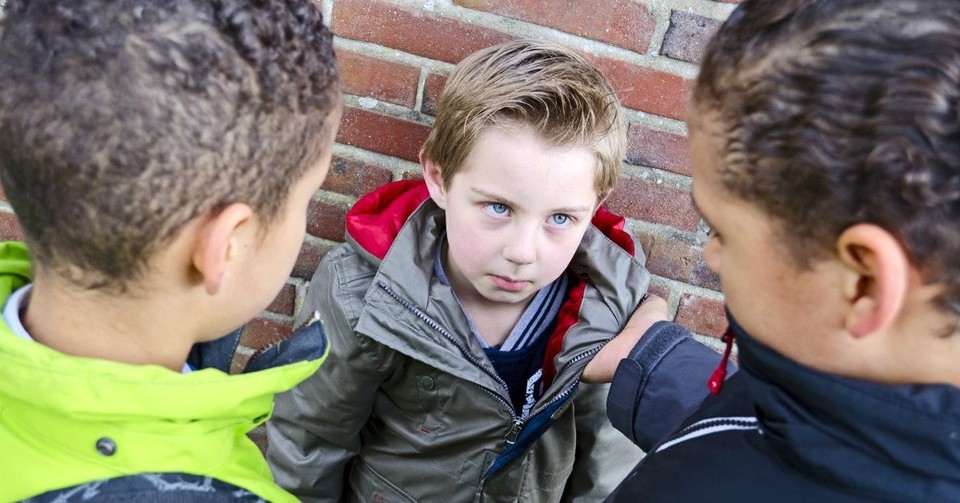3 Steps to Empower Our Children against Bullying

We were at a playground packed with children. The kids were engaged in a variety of activities, often congregating in pockets together. My younger son, who is three, stayed close to his older brother, who is five. He knew the majority of the children were his older brother’s age.
I watched my boys race down the slide, then chase each other back up the stairs and along the platform to do it all over again. They were happily making loop after loop as I watched close by, chatting with a collection of moms who were looking on as well.
At one point, I realized that it had been a couple of minutes since I had seen my littler one. His brother was going down the slide, but where was he? I walked around a corner of the playground and saw him backed up against a landing. An older boy was pretending to throw punches at his stomach. Although his punches were soft and I suspect in play, my younger son was afraid.
“Is he bothering you?” I asked.
My younger son stuck out his bottom lip and nodded. He was not in pain, but he was intimidated.
Although bullying peaks in middle school, children are never too young to learn how to handle its early signs. If they are old enough to play with others and communicate appropriately, there are lessons we can teach them. One easy way to breach the topic of bullying with young children is through story time.
I found such a story in Kathryn Otoshi’s One. In the book, children discover how one character inspires others to stand up to bullying. Characters move from colors to numbers, demonstrating that everyone "counts." It is an abstract but poignant tale that teaches children the power of one voice.
That day on the playground, I reminded my three-year-old about the book. “If someone is bothering you, you need to say ‘No!’ and come find Mommy,” I told him. “Remember Blue in our story?” I whisked him into my arms. His eyes got bigger when I mentioned Blue, as he made the sudden connection. He nodded eagerly in recognition.
True to his color, Blue is blue after being picked on by Red. But Red’s red hot drama is no match for the character One. One, the first number in the book, models standing up and speaking out by saying “No!”
As a parent, I want to empower my children to use their voice to make a difference for themselves and others. Bringing faith into the equation empowers them that much more. Although One is not a Christian book, it demonstrates Christian principles.
The Bible teaches us that one person can indeed make a difference. We know Jesus was just one man who walked on earth, and yet he forever changed history and eternity by doing so as God! There are other scriptural entry points to the lessons found in One:
· Remember that size doesn’t matter. One makes a difference for everyone in the book, and our children can too regardless of their age. Jesus talks about how a mustard seed, which is the smallest of seeds, can make a big difference for the kingdom of God. Matt. 13:31-32
· We are called to be different. One is the only character who has the courage to stand up to Red, and One inspires everyone else. Jesus talks about how we are to be salt in the world – we can’t lose our saltiness, or what is different about us, around others. Matt. 5:13
· We are called to shine God’s light. One brings reconciliation to the group by counting Red at the end of the book. Jesus talks about how we are to shine God’s light to others, which means doing good deeds and working toward healing too. Matt. 5:14-16
With a good book and applicable scripture, we can confidently introduce the topic of bullying to our children. But our effort to empower them would stop short if it did not include some practical advice too. For that, I consulted the local guidance counselor.
Here are three expert tips you can teach your children if someone is bothering them or they see someone else being bothered:
1. Tell a trusted adult right away! Especially in the instance of harm or threat of harm, children should not wait until they get home to tell an adult. Have your children think of one trusted person at school and at home whom they can go to. If they think the adult whom they select is having trouble understanding them, they should tell another adult.
2. They have the power to say, "No!" When someone is bothering them or they see someone else being bothered, they can confront the bully. There is power in numbers, so if it is easier for them to do so by enlisting support, that's okay. A collective response is even more effective.
3. They can befriend the one who is being bullied. If they are tentative to confront the bully, they can be a friend instead. This provides the one who is being bothered with an avenue to get away from the bully. Children should still tell an adult what is happening though!
Before we left the playground that day, I described what had happened to my older son. I encouraged him to step in and stand up for his little brother if he ever noticed that happening in the future.
Our ultimate goal as parents is one of empowerment - we want to inspire confidence, provide lifelines, and invest in our children’s God-given potential to make a difference. With eyes tuned to the world around them, they can accomplish victories that only they can do!

Originally published January 23, 2015.





